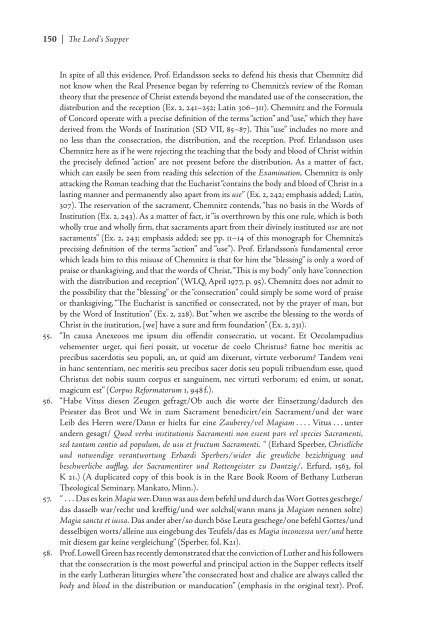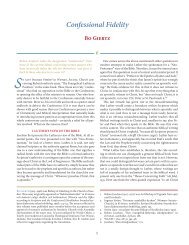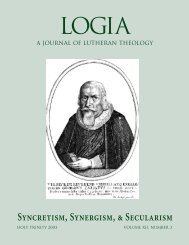The Lord's Supper in the Theology of Martin Chemnitz Bjarne - Logia
The Lord's Supper in the Theology of Martin Chemnitz Bjarne - Logia
The Lord's Supper in the Theology of Martin Chemnitz Bjarne - Logia
Create successful ePaper yourself
Turn your PDF publications into a flip-book with our unique Google optimized e-Paper software.
0 | <strong>The</strong> Lord’s <strong>Supper</strong><br />
In spite <strong>of</strong> all this evidence, Pr<strong>of</strong>. Erlandsson seeks to defend his <strong>the</strong>sis that <strong>Chemnitz</strong> did<br />
not know when <strong>the</strong> Real Presence began by referr<strong>in</strong>g to <strong>Chemnitz</strong>’s review <strong>of</strong> <strong>the</strong> Roman<br />
<strong>the</strong>ory that <strong>the</strong> presence <strong>of</strong> Christ extends beyond <strong>the</strong> mandated use <strong>of</strong> <strong>the</strong> consecration, <strong>the</strong><br />
distribution and <strong>the</strong> reception (Ex. 2, 241–252; Lat<strong>in</strong> 306–311). <strong>Chemnitz</strong> and <strong>the</strong> Formula<br />
<strong>of</strong> Concord operate with a precise def<strong>in</strong>ition <strong>of</strong> <strong>the</strong> terms “action” and “use,” which <strong>the</strong>y have<br />
derived from <strong>the</strong> Words <strong>of</strong> Institution (SD VII, 85–87). This “use” <strong>in</strong>cludes no more and<br />
no less than <strong>the</strong> consecration, <strong>the</strong> distribution, and <strong>the</strong> reception. Pr<strong>of</strong>. Erlandsson uses<br />
<strong>Chemnitz</strong> here as if he were reject<strong>in</strong>g <strong>the</strong> teach<strong>in</strong>g that <strong>the</strong> body and blood <strong>of</strong> Christ with<strong>in</strong><br />
<strong>the</strong> precisely def<strong>in</strong>ed “action” are not present before <strong>the</strong> distribution. As a matter <strong>of</strong> fact,<br />
which can easily be seen from read<strong>in</strong>g this selection <strong>of</strong> <strong>the</strong> Exam<strong>in</strong>ation, <strong>Chemnitz</strong> is only<br />
attack<strong>in</strong>g <strong>the</strong> Roman teach<strong>in</strong>g that <strong>the</strong> Eucharist“conta<strong>in</strong>s <strong>the</strong> body and blood <strong>of</strong> Christ <strong>in</strong> a<br />
last<strong>in</strong>g manner and permanently also apart from its use” (Ex. 2, 242; emphasis added; Lat<strong>in</strong>,<br />
307). <strong>The</strong> reservation <strong>of</strong> <strong>the</strong> sacrament, <strong>Chemnitz</strong> contends, “has no basis <strong>in</strong> <strong>the</strong> Words <strong>of</strong><br />
Institution (Ex. 2, 243). As a matter <strong>of</strong> fact, it “is overthrown by this one rule, which is both<br />
wholly true and wholly firm, that sacraments apart from <strong>the</strong>ir div<strong>in</strong>ely <strong>in</strong>stituted use are not<br />
sacraments” (Ex. 2, 243; emphasis added; see pp. 11–14 <strong>of</strong> this monograph for <strong>Chemnitz</strong>’s<br />
precis<strong>in</strong>g def<strong>in</strong>ition <strong>of</strong> <strong>the</strong> terms “action” and “use”). Pr<strong>of</strong>. Erlandsson’s fundamental error<br />
which leads him to this misuse <strong>of</strong> <strong>Chemnitz</strong> is that for him <strong>the</strong> “bless<strong>in</strong>g” is only a word <strong>of</strong><br />
praise or thanksgiv<strong>in</strong>g, and that <strong>the</strong> words <strong>of</strong> Christ,“This is my body” only have“connection<br />
with <strong>the</strong> distribution and reception” (WLQ, April 1977, p. 95). <strong>Chemnitz</strong> does not admit to<br />
<strong>the</strong> possibility that <strong>the</strong> “bless<strong>in</strong>g” or <strong>the</strong> “consecration” could simply be some word <strong>of</strong> praise<br />
or thanksgiv<strong>in</strong>g, “<strong>The</strong> Eucharist is sanctified or consecrated, not by <strong>the</strong> prayer <strong>of</strong> man, but<br />
by <strong>the</strong> Word <strong>of</strong> Institution” (Ex. 2, 228). But “when we ascribe <strong>the</strong> bless<strong>in</strong>g to <strong>the</strong> words <strong>of</strong><br />
Christ <strong>in</strong> <strong>the</strong> <strong>in</strong>stitution, [we] have a sure and firm foundation” (Ex. 2, 231).<br />
55. “In causa Anexeoos me ipsum diu <strong>of</strong>fendit consecratio, ut vocant. Et Oecolampadius<br />
vehementer urget, qui fieri possit, ut vocetur de coelo Christus? fiatne hoc meritis ac<br />
precibus sacerdotis seu populi, an, ut quid am dixerunt, virtute verborum? Tandem veni<br />
<strong>in</strong> hanc sententiam, nec meritis seu precibus sacer dotis seu populi tribuendum esse, quod<br />
Christus det nobis suum corpus et sangu<strong>in</strong>em, nec virtuti verborum; ed enim, ut sonat,<br />
magicum est” (Corpus Reformatorum 1, 948 f.).<br />
56. “Habe Vitus diesen Zeugen gefragt/Ob auch die worte der E<strong>in</strong>setzung/dadurch des<br />
Priester das Brot und We <strong>in</strong> zum Sacrament benedicirt/e<strong>in</strong> Sacrament/und der ware<br />
Leib des Herrn were/Dann er hielts fur e<strong>in</strong>e Zauberey/vel Magiam . . . . Vitus . . . unter<br />
andern gesagt/ Quod verba <strong>in</strong>stitutionis Sacramenti non essent pars vel species Sacramenti,<br />
sed tantum contio ad populum, de usu et fructum Sacramenti. “ (Erhard Sperber, Christliche<br />
und notwendige verantwortung Erhardi Sperbers/wider die grewliche bezichtigung und<br />
beschwerliche aufflag, der Sacramentirer und Rottengeister zu Dantzig/, Erfurd, 1563, fol<br />
K 21.) (A duplicated copy <strong>of</strong> this book is <strong>in</strong> <strong>the</strong> Rare Book Room <strong>of</strong> Bethany Lu<strong>the</strong>ran<br />
<strong>The</strong>ological Sem<strong>in</strong>ary, Mankato, M<strong>in</strong>n.).<br />
57. “ . . . Das es ke<strong>in</strong> Magia wer. Dann was aus dem befehl und durch das Wort Gottes geschege/<br />
das dasselb war/recht und krefftig/und wer solchsl(wann mans ja Magiam nennen solte)<br />
Magia sancta et iussa. Das ander aber/so durch böse Leuta geschege/one befehl Gottes/und<br />
desselbigen worts/alle<strong>in</strong>e aus e<strong>in</strong>gebung des Teufels/das es Magia <strong>in</strong>concessa wer/und hette<br />
mit diesem gar ke<strong>in</strong>e vergleichung” (Sperber, fol. K21).<br />
58. Pr<strong>of</strong>.Lowell Green has recently demonstrated that <strong>the</strong> conviction <strong>of</strong> Lu<strong>the</strong>r and his followers<br />
that <strong>the</strong> consecration is <strong>the</strong> most powerful and pr<strong>in</strong>cipal action <strong>in</strong> <strong>the</strong> <strong>Supper</strong> reflects itself<br />
<strong>in</strong> <strong>the</strong> early Lu<strong>the</strong>ran liturgies where “<strong>the</strong> consecrated host and chalice are always called <strong>the</strong><br />
body and blood <strong>in</strong> <strong>the</strong> distribution or manducation” (emphasis <strong>in</strong> <strong>the</strong> orig<strong>in</strong>al text). Pr<strong>of</strong>.




